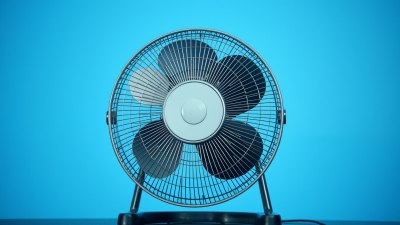Why You Can’t Focus When the Fan’s Not Facing You
Discover why facing a fan improves your focus and productivity by exploring the psychology and physiology behind it.

Image created with Flux Schnell
Many people have noticed a curious phenomenon: they find it easier to concentrate when a fan is blowing air directly at them. When the fan is turned away, or when there's no airflow, their focus seems to waver, productivity drops, and distractions creep in more easily. This seemingly trivial observation has intrigued psychologists, neuroscientists, and productivity experts alike. Why does the direction of a fan’s breeze impact our ability to focus so strongly?
The answer lies in a combination of sensory stimulation, temperature regulation, and psychological effects that together create a conducive environment for concentration. To understand this, we need to explore the physiological and cognitive mechanisms at play when chilled air is directed toward your face.
The Role of Sensory Stimulation in Focus
Humans rely heavily on sensory input to stay alert. Our brains constantly process stimuli from the environment—sight, sound, touch, smell, and taste—to make sense of the world. The sensation of a fan blowing air on your skin stimulates tactile receptors, providing constant mild sensory input that helps keep the brain activated. Without such input, the mind may drift toward daydreams or distractions, making it harder to sustain focus.
The sensation of air movement is especially significant because it activates mechanoreceptors in the skin that respond to light touch and vibration. These receptors send signals to the brain, helping maintain an alert state. When a fan’s breeze is absent, this continuous sensory input is reduced, potentially decreasing cortical arousal and leading to lapses in attention.
Temperature Regulation and Cognitive Performance
Temperature plays a critical role in cognitive functioning. The brain operates best within a narrow temperature range. Overheating can cause discomfort, slowing reaction times and cognitive processing, while feeling too cold can also distract the brain by inducing shivering or discomfort.
When a fan blows air toward your face, it helps regulate facial and upper body temperature by increasing convection and evaporation rates, especially when you’re sweating. This cooling effect prevents overheating and helps maintain an optimal brain temperature, stabilizing mental performance. Conversely, when the fan is off or directed away, heat can build up, causing drowsiness, irritability, and difficulty concentrating.
The Psychological Effect of Airflow
Psychologically, the sensation of airflow from a fan can create a sense of environmental control and comfort. Studies have shown that people who perceive their surroundings as comfortable and under their control tend to perform better on cognitive tasks. The breeze from a fan provides constant, predictable sensory feedback, which can enhance feelings of calmness and reduce anxiety, both of which are important for focus.
Moreover, the rhythmic noise generated by fans offers a form of white noise, which masks distracting background sounds. This auditory consistency further helps to shield your attention from interruptions, enabling longer periods of sustained concentration.
Airflow and Alertness: A Neural Perspective
From a neurological standpoint, minor environmental stimulation such as airflow impacts the locus coeruleus-noradrenergic system, a key brain area involved in arousal and attention. This system regulates the release of norepinephrine, a neurotransmitter that promotes alertness and rapid responses to stimuli.
Mild tactile sensations induced by cooling air activate this system, encouraging a heightened state of awareness. Without these stimuli, this neural activation decreases, leading to slower cognitive responses and reduced focus. Thus, airflow isn’t just a comfort factor—it is intimately linked to the brain’s ability to maintain vigilance.
Practical Implications for Work and Study Environments
Understanding why you can’t focus without direct airflow from a fan has important implications for setting up your workspace or study area. Ensuring consistent, gentle airflow can improve cognitive performance, reduce fatigue, and increase productivity.
Workers in offices, students studying at desks, and even gamers benefit from positioning a fan to blow toward their face or upper body. Especially in warm environments, this simple adjustment can drastically improve concentration.
Office HVAC (heating, ventilation and air conditioning) systems should incorporate airflow strategies that mimic this effect to support worker focus. Personal desk fans or airflow solutions tailored to individual preferences may become critical tools for enhancing workplace productivity.
Why Other Forms of Cooling Don’t Work as Well
You might wonder why drinking cold water or resting in an air-conditioned room doesn’t replicate the same focus benefits as a fan directed at you. The key difference lies in the continuous sensory stimulation and airflow dynamics.
Drinking cold water certainly cools the body internally, but it does not provide the tactile sensation of moving air that keeps mechanoreceptors engaged. Similarly, an air-conditioned room lowers ambient temperature but often lacks the direct, continuous breeze effect that stimulates alertness.
The dynamic friction of moving air on the skin provides unique tactile feedback essential for sustained attention that static cooling methods can't replicate.
The Evolutionary Angle: Why Were We Wired This Way?
From an evolutionary perspective, our sensory and attentional systems developed in environments where moving air often signified important external stimuli—approaching animals, changes in weather, or terrain navigability. The sensation of wind on the skin likely served as a natural alerting mechanism to remain vigilant and responsive.
The brain interprets the airflow similarly, as a subtle but constant external signal, helping keep attention focused on the immediate surroundings and tasks instead of internal distractions. This ingrained neural response explains why facing a fan can subconsciously boost attention.
Potential Downsides and Considerations
Though airflow enhances focus for many, it is not universally beneficial. Some individuals experience discomfort, dryness, or irritation when facing direct airflow for extended periods. Those with sinus issues or sensitive skin might find fans exacerbate symptoms, leading to headaches, congestion, or increased distractions.
Additionally, excessively strong fans can create noise distractions rather than white noise, counteracting productivity benefits. It’s essential to balance intensity and direction to optimize comfort and focus.
Alternative Methods for Stimulating Focus Without a Fan
If a fan is unavailable or unsuitable, alternative approaches can help replicate similar effects. For example, using gentle tactile stimulation like light brushing on arms or wrists can engage mechanoreceptors. Ambient white noise machines can replicate auditory masking benefits similar to fan noise.
Maintaining proper hydration, moderate ambient temperature, and good airflow through open windows or vents also supports cognitive performance. Stretch breaks and physical movement enhance blood flow and alertness, indirectly compensating for the lack of direct airflow stimulation.
Tips to Optimize Your Environment for Focus
To maximize concentration through environmental control, consider the following practical tips:
- Position a fan to gently blow air onto your face or upper body without causing discomfort.
- Choose a fan speed that produces soothing white noise but isn’t distracting.
- Keep the room temperature comfortable, ideally between 20-24°C (68-75°F).
- Use a humidifier if the airflow causes dryness in your eyes or skin.
- Take regular breaks to avoid sensory fatigue from continuous airflow exposure.
- Combine airflow with other focus-enhancing habits like good lighting and organized workspace.
In essence, the reason you can’t focus when the fan isn’t facing you involves multiple intersecting factors: constant tactile stimulation activates alertness pathways; cooling prevents overheating and discomfort; rhythmic fan noise masks distracting sounds; and psychological comfort improves concentration. These components collectively create an ideal microenvironment for sustained cognitive effort.
While simple and often overlooked, the direction of a fan’s airflow can be a powerful tool in improving attention and productivity. Harnessing this knowledge allows individuals to tailor their environments, enhancing performance in work, study, or creative endeavors.
The next time you find your mind wandering without the fan's breeze, it’s not just psychological—it’s physiological and neurological. Facing the fan might just be the subtle nudge your brain needs to stay on task.











